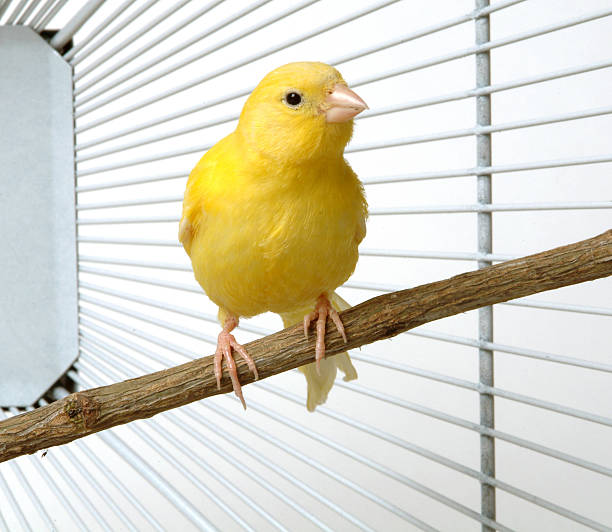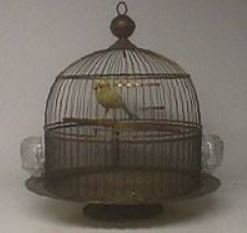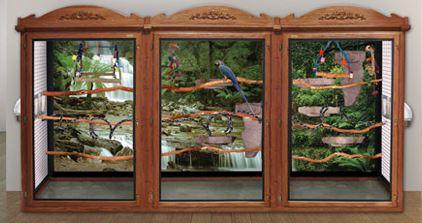The Canary Bird Cage
--Your Canary's Home--
Selecting, Setting Up, and Maintaining Your Canary Bird Cage.
Welcome, this is your ultimate guide to ensuring the optimal living environment for your feathered friend.
Your bird's cage is more than just a shelter; it's their sanctuary and should cater to their specific needs. In this comprehensive resource, we'll delve into crucial aspects of selecting, setting up, and maintaining a canary cage.
From appropriate sizing and bar spacing to essential accessories and cage placement, we'll cover everything you need to know to create a safe, comfortable, and stimulating habitat for your beloved canary companion.
Let's ensure their happiness and well-being together!

FREE Email Course.
Sign up below and get the 5 part email course: "The #1 Problem You Will Face As A Canary Owner"
Selecting The Cage
When selecting a canary bird cage, several factors are crucial. Opt for a cage with bar spacing of 3/8 inch (no wider than 1/2 inches) to prevent escapes or injuries.
Ensure the cage provides ample space for perching, flying, and exploration.
Choose a cage made of sturdy materials, such as stainless steel or powder-coated metal, to ensure durability.
Consider features like removable trays for easy cleaning and multiple doors for convenient access.
Additionally, provide accessories like perches, food and water dishes, and toys to enrich the canary's environment. Prioritize safety, comfort, and functionality to provide the best living space for your canary.
Canary Cage Size and Shape
Many new canary owners start off with the wrong cage so let's start with a "should not"...
The cage should not be tall and narrow as a cage is for a parrot or cockatiel or parakeet. Those birds are climbers and get most of their exercise through climbing up and down the sides of the cage or branch or whatever climbing apparatus is put in the cage.
But canaries don’t climb.
They fly and hop.
It's much more natural for your bird to fly horizontally across the cage rather than up and down in a tall narrow cage.
And if you have a cage that is both wide AND tall, well, now you have an excellent cage with plenty of room for exercise.
We want to keep our canaries as healthy as possible so let's make sure they have room to exercise.
So, your well-meaning sweet Aunt Bessie might say, "Get this cute little inexpensive cage for your canary"....
 Too Small
Too SmallDon't do it. Yeah, it's cute...and it probably has one of those fancy Japanese style roofs on it but guess what...there's a good chance that cage is all wrong.
And if it is all wrong, your canary may suffer, weaken, and live a short miserable life.
How would you like to live in a 5 story closet? It would be impossible for me--even WITHOUT all my wife’s clothes in it!
Even pet store employees will often give bad advice about canary bird cages, so don't feel bad if you've picked out the wrong cage. It's not your fault.
The Correct Canary Bird Cage
Cages for canaries should be at least 20 inches wide with 2 perches...one at each end of the cage.
This is the bare minimum. In fact, I feel a little uncomfortable recommending 20 inches... 24 inches wide or wider is much better.
BIGGER IS ALWAYS BETTER
But with 24 inches your pet bird can comfortably flutter back and forth between the two perches and get plenty of exercise.
MY CANARY CAGE RECOMMENDATIONS...
Exercise and the Canary Bird Cage
An exercising canary is a healthy canary and a healthy canary is a happy canary and a happy canary is a...S-I-N-G-I-N-G canary!
A cage with plenty of length not only gives your pet bird some room to exercise but it gives lots of room to organize his feeders, waterers, toys, and snacks within the canary cage.
If your budget is tight and every dollar counts (Hey, I've been there) you can go a bit smaller but try not to go smaller than 20 inches wide. Your pet canary bird needs room to flutter back and forth, get plenty of exercise, and stay happy and healthy.
If for some reason you're going to use a small cage--and even if you use a
large cage--let your canary out for a flight around the room a few times per week.
He'll have a good ole time.
Obviously, you'll want to make sure the room is "hazard
free". Hot stove tops with pots of boiling water, cats and dogs, and small children can cause
problems.
Also, make sure all windows and mirrors are covered to avoid collisions at full-speed.
Furnishings in a Small Cage
With a small pet bird cage, the feeders and waterers almost always have to be placed under the perches.
This creates a problem with your canary’s droppings getting into his food.
The larger the cage, the more room you'll have for furnishings to be placed somewhere OTHER THAN UNDER A PERCH.
Droppings in the seed dish is never good. And that reminds me, always be watching closely for any unusual symptoms that could indicate the beginning of an illness.
Canary Cage Bars
The bars on the canary bird cage should be no farther apart than 1/2 inch so we can avoid a canary's head getting stuck. Many cages have bar spacing of 3/8 inch and that is best.
Opt for sturdy materials like stainless steel or powder-coated metal to ensure durability. Securely constructed bars provide a safe and comfortable environment for canaries, allowing them to perch and explore without risk.
A powder-coated bird cage is a type of bird cage that has been coated with a layer of powdered paint material. This coating is applied electrostatically and then cured under heat, creating a durable and smooth finish on the cage.
Powder coating provides several benefits, including resistance to rust, corrosion, and chipping, making it a popular choice for bird cages.
Additionally, it is non-toxic, which is crucial for the safety and well-being of pet birds. Powder-coated bird cages are available in various colors and styles and are often preferred for their durability and ease of maintenance.
Shape
The best shape for a canary cage is typically rectangular or square.
These shapes provide ample space for the canary to move around, stretch its wings, and explore its environment.
Additionally, rectangular or square cages allow for easy placement of perches, toys, and other accessories to enrich the canary's environment.
Avoid cages with rounded or curved edges, as they may limit usable space and make it difficult to attach accessories securely. Overall, a spacious rectangular or square cage offers the best layout and functionality for accommodating the natural behaviors and needs of canaries.
Rectangular is best. Don't get a round canary cage.
Your canary will feel more comfortable and secure in a cage with corners.
The theory is that round cages confuse him and he'll find security in corners. Of course, that's assuming that the round cage is not very big. A large round cage, 36 inches across for example, would be OK.
Easy Cage Cleaning
If possible, try and find a cage that has a slide out tray at the bottom or a detachable base for easy cleaning.
Put in a layer of absorbent cage liner, newspaper, paper towel, or even cardboard, then keep it changed regularly.
If you're a gardener, put the dirty liner in a compost pile. No use letting all that good fertilizer go to waste ;)
Remember to clean and disinfect the entire cage on a regular basis.
FINDING The Right Cage
I'll admit, it can be difficult to find a bird cage that is the proper size and attractive at the same time. But there are plenty of rectangular canary bird cages that are tolerable attractive and affordable.
Thinking of breeding canaries some day?
A canary owner might want to get a breeder cage instead of a regular cage for several reasons. Breeder cages are specifically designed to facilitate breeding and nesting behaviors in birds, including canaries
These cages often feature larger dimensions, multiple access doors, and removable dividers or nest boxes to accommodate breeding pairs and their offspring.
They provide a more spacious and comfortable environment for breeding pairs to court, mate, and rear their chicks.
Additionally, breeder cages may have specialized features such as built-in nesting areas or feeding stations to support the breeding process. Overall, breeder cages offer enhanced functionality and convenience for canary owners interested in breeding their birds.
Custom Canary Bird Cages
If price is of no concern and you just want to get a really nice canary bird cage check out these beautiful cages at customcages.com.

Nope, I can't afford those either but a man's got to have a dream!
Well, that about does it for size and shape of the canary bird cage.
Next...Keep in mind cage location‑‑A subject that could mean the difference between a happy singing canary or an unhealthy lethargic canary.
Click here for tips on canary bird cage location.
|
Have A Great Story or Tip About This Topic?
Do you have a great story or tip about canary health care? Share it! It may be of great interest and assistance to other canary owners.








